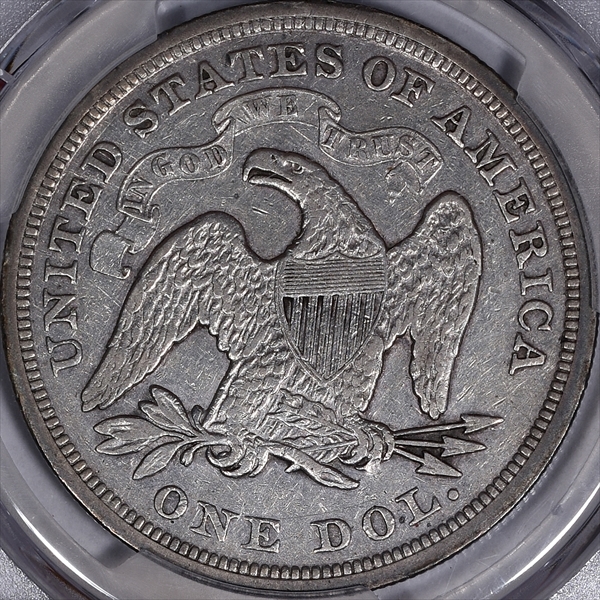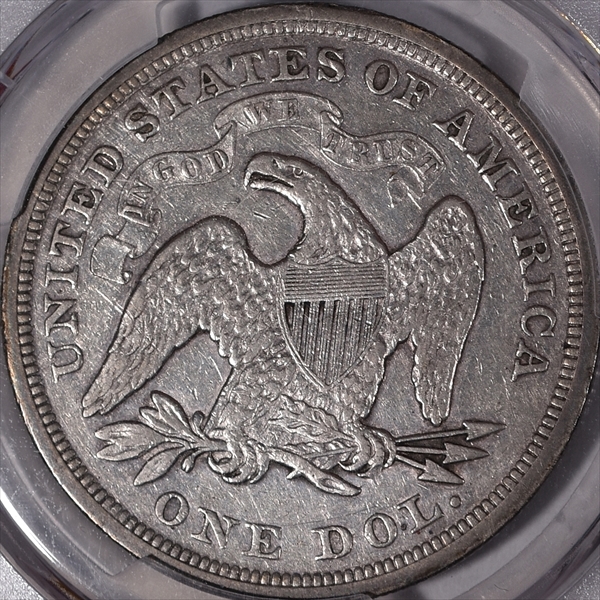1873 $1 Seated VF35 认证号44691184, PCGS号6971
拥有者评论
Heritage auction # 132230, 07/27/2022.
专家评论
Q. David Bowers
The following narrative, with minor editing, is from my "Silver Dollars & Trade Dollars of the United States: A Complete Encyclopedia" (Wolfeboro, NH: Bowers and Merena Galleries, Inc., 1993).Coinage Context
Three different dollars: The year 1873 is especially interesting in the annals of American silver dollars for many reasons: (1) The Liberty Seated dollar was abolished with other denominations. (2) The trade dollar began. (3) This was the first year that the coinage system contained three different dollars made for circulation (the standard or Liberty Seated silver dollar, the new silver trade dollar of heavier weight, and the gold dollar; in the other years, 1878-1885, the Philadelphia Mint made trade dollars only as Proofs). (4) Beyond all these are the rarity of 1873-CC and the mystery of the vanished 1873-S.
By 1873, the melt-down value of the last Liberty Seated dollar issue minted was just a fraction over face value, not enough premium to warrant melting. This situation had not occurred for over two decades previously. Now, at last, Liberty Seated dollars in Treasury vaults and in private vaults of bullion dealers and banks (where many such pieces were held) were free to circulate once again when specie payments were resumed beginning in autumn 1876. That quantities of dollars were indeed held after 1873 is evidenced by a provision in the Act of July 14, 1875 which stated that United States bonds issued in 1870 were payable at the option of the government in standard silver dollars, 412.5 grains, or in gold coin.
The price of silver continued to drop, and in 1874 a Liberty Seated dollar was worth about 99¢ in melt-down value, dropping to 96¢ in 1875, 90¢ in 1876, and rising slightly to 92¢ in 1877. Liberty Seated dollars came out of the woodwork and were once again seen in circulation, particularly in the American West.
Treasury records are ambiguous on the official government attitude on silver dollars. Exactly how the Treasury came to own quantities of certain Liberty Seated dollars in Mint State is not known, in view of the practice at the time of paying out dollars to depositors of silver. Liberty Seated dollars were not minted for the government's own account.
Silver dollar coinage stopped: With the advent of the trade dollar in 1873, the Liberty Seated dollar, long the bane of various Mint directors, suddenly lost any further reason for continuance, and on March 29, 1873, production ended, following the Act of February 12, 1873 (popularly called "the Crime of '73" by its numerous detractors). Among other provisions, this legislation abolished the two cent piece, the silver three-cent piece, the half dime, and the silver dollar, and provided for the coinage of the trade dollar. Changes in weight were made for the dime, quarter, and half dollar. (See information concerning the act given below.)
The Philadelphia Evening Telegram on July 11, 1873 carried this notice on the front page: "The new law went into effect the first of April, and since that time none of the dollars coined prior to that date have been paid out." After July 10, 1873, many undistributed pieces still held at the Mint went to the melting pot. Included in the destruction was the large quantity of 2,258 unsold Proof dollars of 1873 and unspecified earlier years.
Commenting on the Act of April 12, 1873, W.A. Shaw in The History of Currency, 1252 to 1896, Second Edition, 1896, noted this: "The silver dollars previously coined (few of which were in existence) maintained their quality as legal tender. ... " This is still another indication that Liberty Seated dollars were rare in their own time.
Numismatic Information
Closed 3 date numeral: All 1873 Liberty Seated dollars have the Closed 3 date logotype; knobs of 3 are large and close together. No Open 3 pieces were made. Some 293,000 circulation strikes came from several obverse dies distinguished from each other by minor differences in position.
1873 circulated grades: Many if not most 1873 Liberty Seated dollars went to the melting pot. Specimens of coins in circulated grades from Very Fine to AU are much rarer today than the mintage indicates.
Availability of Mint State grades: The 1873 is quite rare in Mint State, but not as rare as one might think. However, they are not significantly more elusive than are circulated pieces (which, as noted, are not easy to find). Mint State coins seen by me have been sharply struck and very frosty.
As early as 1977, which is "ancient history" in the annals of research on Liberty Seated dollars, Ron Severa, writing in The Gobrecht journal; noted that in Extremely Fine condition 1873 is not a common date and is "very undervalued." On the other hand, in July 1982 Donald Vettel did not hesitate to say that the 1873 was "uncommon" but "overpromoted."
Caveat emptor: In the early 1970s a number of cast counterfeits of the 1873 Liberty Seated dollar and the 1873 trade dollar appeared in numismatic circles. These are believed to have been made in Southeast Asia. Examples seen are very sharp and have a microscopically granular surface.
Varieties
Circulation strikes:
1.Normal Date: Breen-5494. Closed 3 in date. (All trade dollars of 1873 have open 3: knobs of 3 smaller, especially the upper one, and farther apart. Special credit is due Harry X Boosel, who over a period of years has studied the year 1873 intensively and has brought to light much information concerning numismatic issues of the time. See text.)
Knobs of 3 large, about equal in size, close together. Positional varieties exist among circulation strikes but have not been classified.
Dies prepared: Obverse: Unknown; Reverse: Unknown
Circulation strike mintage: 293,000; Delivery figures by day: January 7: 9,000;January 16: 21,500; February 17: 21,000; February 18: 4,000; February 25: 21,000; March 3: 20,000; March 4: 7,000; March 6: 12,000; March 8: 11,000; March 10: 11,000; March 11: 10,000; March 14: 18,000; March 15: 13,000; March 17: 11,000; March 1: 14,000; March 19: 10,000; March 20: 15,000; March 24: 17,000; March 26: 20,000; March 27: 16,000; March 29: 11,500.
Estimated quantity melted: Many were melted at the Mint after July 10, 1873.
Characteristics of striking: Varies; some with lightly struck details on Miss Liberty's head and light strike on stars, especially 8 through 10. Some Mint State coins have satiny surfaces. Others are partially prooflike.
Known hoards of Mint State coins: None
Commentary
Many specimens were melted of this, the last Liberty Seated silver dollar issue.
Additional Information
The Act of February 12, 1873
As finally passed, the Act of February 12, 1873 stated the following, among other provisions:
"SEC. 15. That the silver coins of the United States shall be a trade-dollar, a half-dollar, or fifty-cent piece; a quarter dollar or twenty-five cent piece; a dime, or ten-cent piece; and the weight of the half-dollar shall be twelve grams (grammes) and one-half of a gram (gramme); the quarter-dollar and the dime shall be respectively, one-half and one-fifth of the weight of said half-dollar; and said coins shall be a legal tender at their nominal value for any amount not exceeding five dollars in anyone payment. ...
"SEC. 28. That silver coins other than the trade-dollar shall be paid out at the several mints, and at the assay office in New York City, in exchange for gold coins at par, in sums not less than one hundred dollars, and it shall be lawful, also, to transmit parcels of the same, from time to time,• to the assistant treasurers, depositories, and other officers of the United States, under general regulations proposed by the director of the Mint, and approved by the secretary of the Treasury; but nothing herein contracted shall prevent the payment of silver coins, at their nominal value, for silver parted from gold, as provided in this act, or for change less than one dollar in settlement for gold deposits: Provided, That for two years after the passage of this act, silver coins shall be paid at the Mint in Philadelphia and the assay-office in New York City, for silver bullion purchased for coinage, under such regulations as may be prescribed by the director of the Mint, and approved by the secretary of the Treasury ....
"SEC. 66. That the different mints and assay offices authorized by this act shall be known as 'the Mint of the United States at Philadelphia,' 'the Mint of the United States at San Francisco,' 'the Mint of the United States at Carson,' 'the Mint of the United States at Denver, (Although the federal government made provision for a mint at Denver as early as 1862, when the facilities of Clark, Gruber & Co., bankers and assayers of that city, were acquired, the Denver Mint did not strike coins until 1906, by which time it was set up in a new building. Before that time, it functioned only as an assay office, making bars of gold, silver, or unparted mixtures.) the United States assay-office at New York,' 'the United States assay-office at Boise City, Idaho,' 'the United States assay-office at Charlotte, North Carolina;' and all unexpended appropriations heretofore authorized by law for the use of the Mint of the United States at Philadelphia, the branch Mint of the United States in California, the branch mint of the United States at Denver, the United States assay-office in New York, the United States assay-office at Charlotte, North Carolina, and the United States assay-office at Boise City, Idaho, are hereby authorized to be transferred for the account and use of the institutions established and located respectively at the places designated by this act. ... "
1873 Coins in Numismatics
The year 1873 is remarkable for having the rarest Carson City silver dollar (the 1873-CC) and the most enigmatic of all Liberty Seated dollars, the 1873-S, and its companion issues, the 1873-5 half dollar without arrows (of which no specimen is known to exist), the 1873-CC dime without arrows (the Eliasberg Collection coin is the only one known), and the 1873- CC quarter without arrows (just four are known); one of the rarest circulation strike gold dollars (1873 Closed 3); and the Proof-only 1873 $3 piece with its various restrikes.
The 1873 Proof sets contained more coins than any other in history: Indian cent, two-cent piece (last year of the denomination), nickel three-cent piece, silver three-cent piece (last year of issue), Shield nickel, half dime (last year of issue), dime without arrows at date, dime with arrows at date, quarter without arrows at date, quarter with arrows at date, half dollar without arrows at date, half dollar with arrows at date, silver dollar, trade dollar, gold dollar, quarter eagle, $3 gold piece, half eagle, eagle, and double eagle. Early sets sold by the Mint lacked the trade dollar and silver coins with arrows; later sets lacked the two-cent piece, trime, half dime, silver dollar, and smaller silver without arrows. To contain all of the Proof variations, sets had to be assembled outside of the Mint.
PCGS #
6971
设计师
Christian Gobrecht
边缘
Reeded
直径
38.10 毫米
重量
26.73 克
铸币数量
293000
金属成分
90% Silver, 10% Copper
更高评级数量
249
评级较低的钱币数量
75
地区
The United States of America
价格指南
PCGS 数量报告
拍卖 - PCGS 评级的
拍卖 - NGC 评级的
稀有性和存量估计 了解更多
| 所有评级 | 850 |
| 60或以上 | 150 |
| 65或以上 | 6 |
| 所有评级 | R-5.3 |
| 60或以上 | R-7.5 |
| 65或以上 | R-9.7 |
| 所有评级 | 6 / 15 |
| 60或以上 | 11 / 15 TIE |
| 65或以上 | 6 / 15 TIE |
| 所有评级 | 8 / 45 |
| 60或以上 | 38 / 45 TIE |
| 65或以上 | 21 / 45 TIE |




























